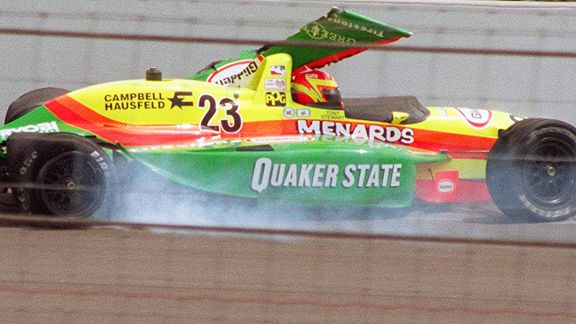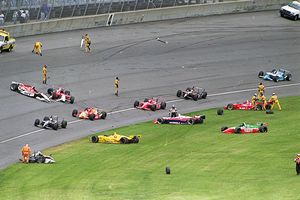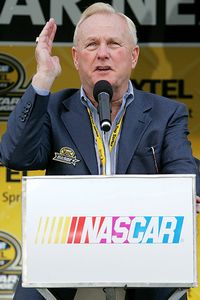George's devastating victory
Editor's note: ESPN.com senior writer Ed Hinton has spent more than 35 years covering motorsports across the globe for entities including Sports Illustrated, The National Sports Daily, Tribune Newspapers and the Atlanta Journal-Constitution. This four-part series, The Damage Done, is his memoir of what he saw and reported leading up to the American open-wheel civil war and the consequences it wrought. This is Part IV, Hell Of A Vision.
Part I | Part II | Part III | Part IV
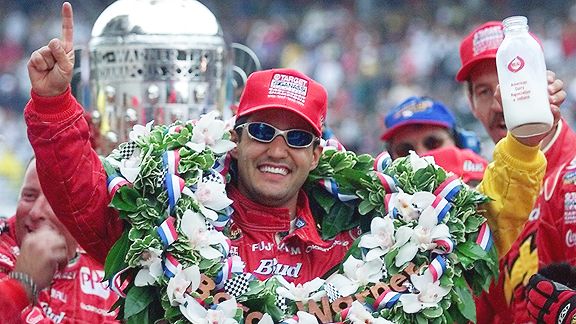
Jeff Haynes/AFP/Getty ImagesThe milk tasted good for Juan Pablo Montoya after winning the 2000 Indianapolis 500. It was a sweet victory for CART owners and fans, too. Montoya thrashed his IRL competition, making a statement about which series had the better drivers -- and teams.
A year after Leo Mehl, the executive director of the IRL, had said the CART teams "would get their doors blown off" if they ventured to Indy in IRL equipment, team owner Chip Ganassi took him up on the challenge.
It was the first return to Indy by a CART team.
In 2000, Ganassi bought IRL cars for the Indy 500 only, for a team that featured Jimmy Vasser but starred '99 CART champion Juan Pablo Montoya, who was essentially farmed out to Ganassi by Formula One team owner Frank Williams.
IRL partisans considered Ganassi's entry the first stage of a CART surrender.
Some surrender.
Ganassi's team would crush the IRL competition.
For Montoya, the Indy 500 was child's play. Conventional wisdom had been to proceed cautiously through the first 400 miles and get the car just right for the final 100. Montoya shattered that notion, running all-out, all the time, due to his F1 training.
The "rookie" dominated, taking the lead on the 27th lap. From there he led all but six of the total 200 laps, falling out of the lead only briefly after pit stops. It was as near to a perfect Indy 500 as had ever been driven.
So much for the CART teams getting their doors blown off.
Mehl had agreed from the outset to serve only three years at the helm of the IRL. By 2001, with Mehl retired and his prediction refuted, storied Team Penske returned to Indy and won it with Helio Castroneves.
In two 500s, the score was CART 2, IRL 0. There was absolutely no doubt which side had the quality and the talent.
But later that year, CART suffered the debacle at Texas. Running their own cars, much faster than those of the IRL, on the 24-degree banking, drivers became disoriented due to high G-forces. The cars couldn't be adjusted enough. CART physicians, including Dr. Steve Olvey, called conditions too dangerous. The race was cancelled. Texas Motor Speedway sued CART, and the expenses of defending that suit, plus the settlement, plunged CART further toward bankruptcy.
By '02 it was clear that any reconciliation would now be far too little, far too late. And yet, for the 500 itself and the 500 only, most of the top CART teams returned that May, in IRL equipment.
You could say everybody who was anybody in American open-wheel racing was back at the 500. Trouble was, hardly anybody there was anybody anymore on the world stage of motor racing, with the exceptions of Al Unser Jr. and Michael Andretti, both in the twilight of their careers.
Team Penske in '02 became the first major, full-time defector from CART to the IRL. Roger Penske's pragmatism was showing: he could run Indy regularly, and the pickings were easy both in the 500 and out on the IRL tour.
But such movement now meant little to the general public, what with both leagues struggling and NASCAR all the rage.
Indeed, between qualifying and the 500, on a midweek flight from Indianapolis to Atlanta, I sat directly behind Castroneves. Nobody else on the plane seemed to recognize the defending Indy 500 champion, who was trying for a repeat win.
By comparison, NASCAR stars such as Jeff Gordon and Dale Earnhardt Jr. flew only on private jets, not daring to take commercial flights, lest they be mobbed by fans.
Then on Thursday of race week, another wall collapsed on beleaguered CART, with one announcement.
"Today, American Honda announces that we plan to enter the Indy Racing League next season, 2003," Robert Clarke, the manufacturer's U.S. racing director, said at a news conference.
In the interview room I turned in my seat, looked at fellow journalists Robin Miller and Gordon Kirby and mouthed, "It's over." Meaning the war. This wasn't quite checkmate, but CART was now being checked at every move.
Mercedes-Benz had already pulled out of CART, and now Honda was leaving. That left Ford as the sole supplier, and a tenuous one at that. Honda would join Toyota, GM and Nissan among IRL engine suppliers.
When Castroneves won his second straight Indy 500, this time as an IRL points competitor in a controversy with CART driver Paul Tracy, favoritism was charged.
On the next-to-last lap, Tracy of CART's Team Green passed Castroneves just as a caution came out. IRL officials ruled Tracy had passed a split second after, rather than a split second before, caution lights had come on in the turns and in the cockpits, officially stopping all racing for position.
The win was awarded to Castroneves, and made official after an initial appeal the following day. The appealing went on for months of examination of electronic data, but Castroneves kept the win.
CART was checked again from another direction when the series sponsor, FedEx, pulled out at the end of '02.
Struggling to restructure, CART even jettisoned its name.
For 2003, embracing its remaining sponsors, tire supplier and engine supplier, the series gave itself arguably the most awkward and cumbersome name in the history of motor racing: Bridgestone Presents The Champ Car World Series Powered by Ford.
Intending humor, I asked the publicists for the carcass of CART if we could shorten the series name in print to "BPCCWSPF." Nobody laughed.
By the end of '03, with its stock trading at pennies per share, the organization declared bankruptcy.
Here sat Tony George, reigning over scorched earth. Here sat the two of us, in his private suite, high in the tower above the pit road at Indianapolis, with a panoramic view of the world's most massive grandstands, which were empty.
This was in May of 2004, eight years into the war, on a late qualifying day for the 500. Only occasionally would a lonely sounding car rumble onto the track.
In bankruptcy court, George had bid to buy the carcass of CART, but the judge had ruled in favor of a small group bent on keeping the body twitching, rather than driving a stake through its heart, as George would have.
For a man who had all but won the war (but what had he won, really?), George seemed very tired that afternoon. At first I thought he must not have slept much lately. But as an hour or so passed, I wondered if this was war-weariness, deep and lasting.
For all he'd tried to do, all he'd spent, all the enormity of the controversies he had stirred, the IRL had become "another CART," critics said -- dominated by foreign drivers the public simply wasn't embracing.
Now he yawned occasionally as I reminded him of all the drivers who could have bolstered his domain, who had started out in open-wheel cars, but had been lost to NASCAR: Jeff Gordon, Tony Stewart, Ryan Newman, Kasey Kahne … and soon, defections to NASCAR from the top ranks of the IRL would start, as drivers chose to move up to the dominant series in America -- the real and clear winner of the Indy car civil war.
“
Having missed the opportunity with Jeff Gordon, we tried to create some opportunities by having the IRL be predominantly an open-wheel, oval series, to afford some guys some opportunities to advance. Some did, with varying degrees of success. But for the most part, car owners again didn't want to take the risks. ” -- Tony George
Years ago, under the old United States Auto Club feeder system, the dirt-trackers would have come here.
"Years ago meaning decades ago, meaning the '50s, '60s, possibly even the '70s," he said, clearly meaning the ladder -- the steps necessary to aspire to Indy car racing -- was long gone.
George thought back through history, back to his teenage years and young adulthood, when the CART barons came and took over.
"Once USAC ceased sanctioning the championship trail, all races beyond Indianapolis, is when that [the USAC ladder] ceased to be the case," he said. "The CART car owner organization, which was comprised primarily of road racing car owners making up their fields, they were more oriented toward developing more road races as opposed to more oval races … and as a result they brought [in] drivers that would contest for a championship. At that point the focus and the emphasis shifted."
Now George included a name that had been in his mind as he'd founded the IRL.
"Having missed the opportunity with Jeff Gordon, we tried to create some opportunities by having the IRL be predominantly an open-wheel, oval series, to afford some guys some opportunities to advance. Some did, with varying degrees of success.
"But for the most part, car owners again didn't want to take the risks."
The IRL owners, many of whom he'd subsidized -- by that point rumored to be to the tune of more than $250 million of the Hulman-George fortune -- had become like the CART owners, seeking drivers who could buy rides.
Even A.J. Foyt had gone international, with various drivers, and even won the '99 Indy 500 with Sweden's Kenny Brack.
"They were either going for drivers with experience and money, or drivers with money," George said.
The one exception had fizzled: "I think everybody knows that John Menard had an opportunity to sign Tony Stewart to a long-term deal," George said. "He chose not to, or he wasn't successful in doing it."
This, even though Menard, George reminded me, was (and remains) a multibillionaire.
And now George acknowledged something monumental, something impossible to overcome, something that flashed the sign, "Game Over."
The USAC ladder system was impossible to restore because it no longer worked for Indy cars at all. It had become, in fact, a fine feeder system for NASCAR.
Through evolution, rear-engine Indy cars by now behaved very differently than front-engine sprint cars and midgets, which now behaved more like front-engine NASCAR cars.
"As far as having a feel for the way the cars drive, off the right rear, coming up through those series [of sprints, midgets and Silver Crown on ovals] -- [drivers are] probably more suited today towards a career path toward NASCAR. They seem to do better," George said.
The USAC system that had produced A.J. Foyt, Johnny Rutherford, Mario Andretti and all the Unsers for Indy was now churning out the likes of Gordon, Stewart, Newman and Kahne for NASCAR.
So George's quintessential intent for the IRL, bringing heartland Americans to Indy from the dirt tracks, was finished.
Any ladder system for Americans to Indy now must include a progression of rear-engine formulas.
For that, "We have a sort of disjointed, dysfunctional ladder system here in the United States," George said. "It's not as clearly defined as it is in Europe."
What was needed? He described a system America didn't have, and still doesn't, and probably won't have anytime soon:
"If we had a better single-seat, rear-engine formula ladder system to encourage and develop young American drivers from go-karts up through IndyCar [now the brand name of his series] to Formula One, there'd probably be a lot more American drivers. Not from the USAC sprint, midget, Silver Crown divisions, but American drivers nonetheless. Someone like a Sam Hornish or an Alex Barron who grows up with an orientation toward racing formula cars."
(Hornish, George's best American hope of the time, would of course eventually defect to NASCAR himself.)
At this point, I thought, "Game Over."
With one feeder system diverted to NASCAR, and the proper feeder system virtually nonexistent, just where was George supposed to get stellar young American drivers the public would embrace?
Out of the blue?
Maybe. Just maybe …
A few days after my long, subdued interview with George, Bobby Rahal -- a one-time CART hard-liner, who now owned a team in the IRL with TV host David Letterman -- held a news conference.
Beside him sat a diminutive, dark-haired, dark-eyed woman with a cold, determined glare. Rahal would enter a car for her in the next year's Indy 500.
Danica Patrick.
I went straight back to my laptop in the media center and wrote immediately that the next year, a woman would enter the 500 capable of winning -- not just participating, as Janet Guthrie and Lyn St. James and Sarah Fisher had done before her.
I'd been introduced to Danica by St. James some years earlier, when Danica was 15, a go-kart champion and interning with St. James' team at Indy. St. James had advised me I'd better talk to this teenager and pay attention to her career, because she was going somewhere.
Danica soon set off for England, to train in the British "schooling formulas" -- a ladder system starting with simple cars such as Formula Vauxhall, and building up. It was slam-bang racing, brutal, cold, unforgiving -- and rife with British mechanics bewildered by the notion of a woman racing.
At a Formula One race in '99, I was working on a story about whether any Americans had hopes of an F1 ride, and three-time world champion Jackie Stewart enunciated one name clearly and firmly to me: "Danica Patrick."
Stewart and his son Paul, with Ford Motor Co., were backing Danica in the schooling formulas and hoped to move her up to Formula 3, only two steps away from F1.
But after Danica's first year in England, Paul Stewart fell seriously ill and Danica was left pretty much on her own. Her father, T.J. Patrick, would tell me years later he'd spent about $500,000 of the family's money to keep her racing in Europe.
Coincidentally, Bobby Rahal had taken a job as team principal of the Ford-backed Jaguar F1 team. It was during his brief stint there that he discovered Danica, when she finished second at a Formula Ford festival in France.
During Indy race week of 2003, I saw one of the publicists for Rahal's Indy car team, walking maybe 30 yards away through the Speedway's enormous media center, accompanied by a tiny woman who -- there was something familiar.
It was the cold, confident glare in the eyes. Rahal had brought Danica home from England for good, and would field a car for her that year in the Formula Atlantic series in the U.S.
By May of '04, Rahal was confident enough in her ability that he called the news conference at Indy. He surprised even her. She learned along with the media that she would drive at Indy in '05.
Her response?
A cool, poker-faced, "Thanks, Bob."
As for the 500 itself that year, the winner's name, Buddy Rice, was so obscure that most of the media focused on the angle of, "David Letterman's car won the race," even though Letterman was mainly a figurehead partner with Rahal.
She arrived at Indy in '05 almost literally as a blur, clocking the fastest lap of pre-qualifying practice, 229.880 mph. In qualifying, a gust of wind kept her from winning the pole, turning her car sideways on the first of her four laps. But she caught it, and still averaged 227.773 to earn the fourth starting spot, highest to that point by a woman at Indy.
In the race, she made some mistakes early but came back to become the first woman to lead the Indy 500. She led twice, the second time being electrifying, when she blasted past Dan Wheldon with 11 laps remaining.
She could win this thing. For the first time in years, the hallowed old grounds were electrified, and the roar of the crowd was virtually drowning out the engine noise.
And you could sense the long-comatose Indianapolis 500's eyes flickering open.
Just as suddenly, they closed. Trying to conserve fuel to finish, Danica's crew ordered her to turn her fuel-management system from richer to leaner, stifling her car's power. Wheldon got past her with six laps left, and then came Vitor Meira and Bryan Herta, to leave her fourth at the checkered flag -- still best to that point by a female driver.
But she hadn't won, and the enormous gasp of life that had welled in Indy's throat subsided.
But not until the next race, at Texas Motor Speedway, did I realize this diminutive, determined, talented -- and, yes, she's glamorous, and she flaunts it -- woman could not save Indy car racing singlehandedly.
From the drivers' meeting at Texas, Buddy Rice emerged wearing a T-shirt that read, "Danica's Teammate."
Vitor Meira's T-shirt read, "Danica's Other Teammate."
And Dan Wheldon's T-shirt read: "Actually Won Indianapolis 500."
Cute, but the T-shirts smacked of resentment. The three young males flouted the positive impact the woman had had. They felt slighted, robbed of their own self-perceived importance.
This was a core sampling of the motley driving corps Tony George had managed to scrape together -- Rice the only American among them -- and they had a tough time accepting Danica.
She could not save the IRL; it would not let her.
Indy's eyes flickered open again in '06, late in the race, over a 19-year-old, third-generation driver from the best-known, most-beloved family in American racing: Marco Andretti.
On Friday, I sat in the team compound with Marco's "Nonno Mario," the family's Italian term for Grandpa Mario, and asked the patriarch -- the '67 Daytona 500 winner, the '69 Indy winner, the '78 F1 world champion -- if there was any realistic chance a 19-year-old rookie could win this race.
He looked me in the eye. All the sadness of the Andrettis at Indy was there, all those disappointments, all that atrocious luck for all those years for him and son Michael, Marco's father. For 37 years of Andretti tears, they had just Mario's '69 win to show.
Mario pondered for seconds; it seemed like minutes.
Then he said, "You're damn right there is." And he repeated, even more adamantly: "You're damn right there is." Again and again he repeated it, until it was but a whispered refrain
Then the haunting caveat came back.
Fast as Marco had been that month, there remained the Andrettis' longtime nemesis, the purveyor of much of their heartbreak, especially for Michael -- Roger Penske.
After the "damn right" refrain had died away, Mario sat silent for another moment, then added: "But you've still got to beat Penske."
Penske's drivers over the years had won the Indy 500 a runaway record 13 times, and now his team was going for No. 14. So it was not prescience that darkened Mario's tone; it was just reality.
With two laps left in the race, Marco shot past his father into the lead, leaving Michael doomed to an 0-15 record at Indy. But the prospect of a 19-year-old winner, an Andretti, electrified the crowd of nearly 300,000 as not even Danica Patrick had the year before.
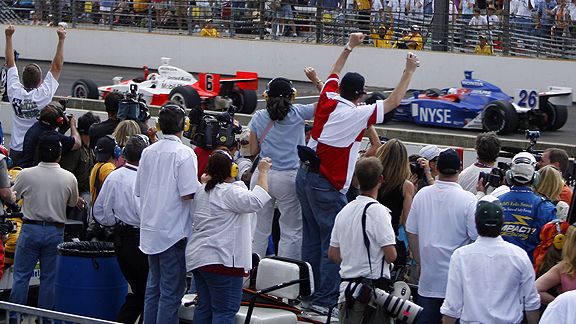
Brian Spurlock/US PresswireThe crowd was electrified the final lap of the 2006 Indy 500; an Andretti -- 19-year-old Marco -- was winning ... but he had to beat Penske. Penske's Sam Hornish Jr. charged like a rocket off Turn 4, and the Andretti curse continued.
But then there appeared the nemesis, in a red-and-white blur, Sam Hornish Jr. of Team Penske, rocketing past Michael into second place and then going after Marco.
Marco at first blocked Hornish, broke his momentum and got some margin as Hornish fell back.
"That's the race," Robin Miller said to me in the media center. We both knew what that meant: the resurrection of Indy in the world's headlines the next day.
Andretti was a globally charismatic name. How deep did it run through the world's social fabric? Well, Mario wanted for his grandson the same sort of gratifying grassroots recognition he had felt, he'd told me years earlier, when he would "walk into some drugstore in some obscure section of Paris or Madrid or Sao Paulo … "
The names Andretti, and Indy, were at the brink of rocketing to the pinnacle again.
But the red-and-white nemesis kept coming, regaining ground, and Mario's words of Friday flashed through my mind: "But you've still got to beat Penske."
Hornish's car was a missile off the fourth turn, and at the checkered flag, he beat Marco by a car length.
Somehow I could sense the Indy 500's eyes closing forever, lapsing into permanent coma, at that moment. For the second year in a row, an inkling of recovery for the grand old race had flickered and then faded.
EPILOGUE
By 2008, as many Indy 500 winners (four) would try to qualify for the Daytona 500 as for the Indy 500 itself.
Juan Pablo Montoya, Dario Franchitti and Sam Hornish Jr. competed at Daytona, and '95 Indy winner Jacques Villeneuve failed to make the Daytona field.
At Indy that year, the former winners who showed up were Helio Castroneves, Dan Wheldon, Buddy Rice and Buddy Lazier.
During Daytona 500 week, on Valentine's Day, what was left of CART -- called, without sponsors, just the Champ Car World Series -- filed for its final bankruptcy.
On Feb. 22, a "merger" into the IRL was agreed to, but amounted mainly to the IRL's purchase of what few desirable assets the old rivals had left, including their highly respected medical unit, and lucrative road and street racing events such as the Long Beach Grand Prix.
Tony George finally had driven a stake through CART's heart.
But he had failed to re-Americanize Indy car racing, and in the end had to resort largely to road racing by foreign drivers for what was now known solely as the IndyCar series.
In June of 2009, George was ousted as CEO of Indianapolis Motor Speedway by his three sisters, all reportedly weary of the hemorrhaging of family money -- by this point as much as $500 million, by some estimates -- into the IRL.
George then resigned as president of the IRL.
To this day, neither Danica Patrick nor Marco Andretti has won the Indy 500. Each has but one win in the IndyCar series.
Now, Patrick is transitioning to NASCAR. While she continues to drive Indy cars, she is learning NASCAR from the ground up and is expected to land there full time in the next few years.
In January of 2010, George appeared to be disappearing from auto racing altogether, after he closed the individual IndyCar team he had founded.
He declined an update interview for this series. Lately he has refused, via e-mail, to tell me what he's up to. But word is, he's trying to reestablish the team.
The essence of Tony George's intentions, throughout the two tempestuous decades since he ascended the Indy throne, is reflected in the team's name.
He calls it Vision Racing.
Ed Hinton is a senior writer for ESPN.com. He can be reached at edward.t.hinton@espn.com.
©2010 ESPN Internet Ventures. Terms of Use and Privacy Policy and Safety Information/Your California Privacy Rights are applicable to you. All rights reserved.
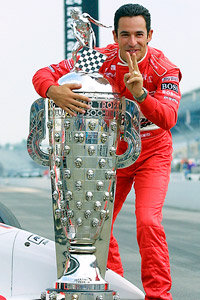
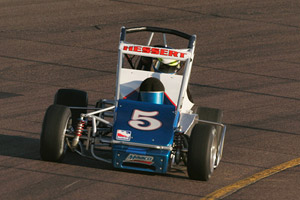
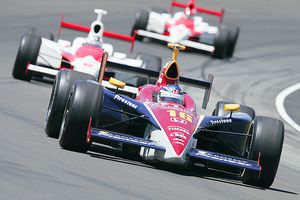
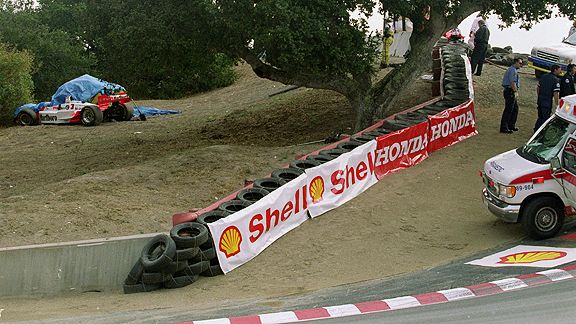

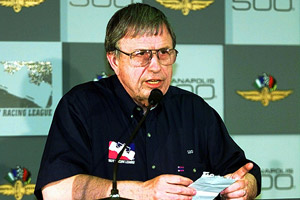
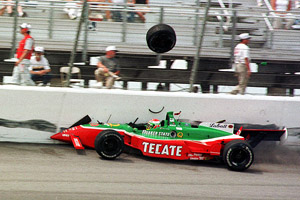
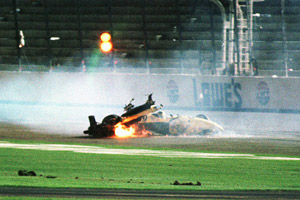



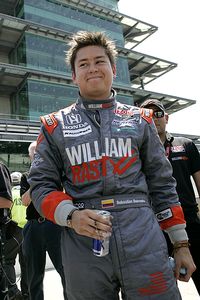

 ... they could change it [the Indy 500] into a NASCAR race and I don't believe the American public would blink an eye. They wouldn't be upset at all. In fact, they'd probably be more enthusiastic now, because it would go back to being an all-American sports spectacular.
... they could change it [the Indy 500] into a NASCAR race and I don't believe the American public would blink an eye. They wouldn't be upset at all. In fact, they'd probably be more enthusiastic now, because it would go back to being an all-American sports spectacular.